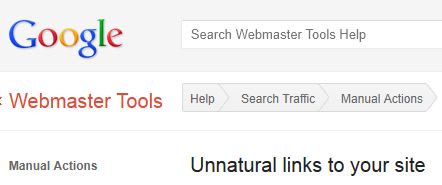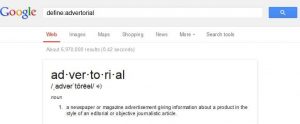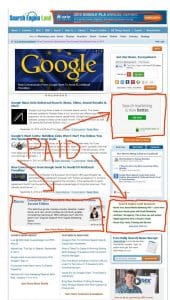
No website owner wants to log into Google Search Console and see an unnatural link warning from Google. Yet it’s happening to more and more websites every day.
From what I am see in the the past few years of helping website owners with manual actions, many of these unnatural link warnings and manual penalties from Google are a result of having participated in advertorials. Google wants links in advertorials to be tagged with the nofollow attribute and the FTC requires full disclosure. So how does Google find and penalize websites who have links from advertorials? If we understand this, as a website owner, you can make sure that your links will pass the “sniff test”, thus keeping yourself away from Google’s radar, which means that there is less of a chance that you will receive an unnatural link warning from Google.
First, a little background
Back in 2003, when Google was beginning to crack down on paid links, I had a conversation with Shari Thurow about how Google determined, in an automated fashion, whether a website contained paid links or not. In order for Google to “deal” with the thousands or tens of thousands of websites buying and selling paid links was a tremendous task. The only way that they could deal with it all was to use some sort of way to determine which pages contained paid links and which did not: in an automated fashion. Then, perhaps deal with those sites that they found.
Back then, it was a really interesting concept: Google looked at a web page as a whole, and breaks up that web page up into different “parts”. Kind of like several “blocks” or rectangles, so to speak. The likelihood of a list of paid links appearing on the sidebar (the left or right side) of a page, and even in the footer, was very good. Paid links very rarely appear in the navigation of a site, or even in the middle of the text on the page, the main content, within the middle of sentences (more on this later). Take a look at the example below. The likelihood of paid links appearing in the sections that I’ve highlighted in red below is a good example of this.
I’m using Search Engine Land in the example above. There are clearly marked “sponsored” blocks of text (and ads) that are paid links. Although one of the sponsored ads appears in the middle of the page, it just happens to be marked “sponsored” and is next to more text link ads that are sponsored, as well (the ones of the right side). I would like to note that those text link ads do not appear to have the “nofollow” attribute on them.
If Google were looking at the web page (SE Land) today (which I am sure their system is doing), they could fairly easily identify which links are paid (sponsored) and which ones are not.
How Does Google Identifies Advertorials?
Unfortunately, we do not have access to Google’s internal algorithm and how they are identifying issues on websites that they deem to be against their Google Webmaster Guidelines. One of these major issues that they’re dealing with right now (thus this blog post) is the subject of advertorials. Certainly I don’t have access to how they actually identify advertorials, but let’s examine the likelihood of how they do it.
What we know is that Google has to work in identifying advertorials into their algorithm–or one of the “checks” or “processes” that they run from time to time to deal with what I would call “advertorial spam”. It just simply is not “scaleable” to identify advertorials solely based on spam reports that they receive from users or manually review websites. So, what Google does is identify the typical “footprint” of advertorials across the board, and then narrow them down to a specific list of URLs that are most likely advertorials. At that point, how they deal with them is anyone’s guess. Whether or not Google has someone actually manually review those URLs and then decide to give the site that’s benefiting from the advertorial a manual link warning is also anyone’s guess. But my suspicion is that Google’s filter first identifies the sites and then someone works off a list of some sort.
So how could Google identify the footprint of advertorials? Luckily, I have personally dealt with manual link warnings by Google (this is something I specialize in), and have seen the actual URLs that Google has given us as examples: which were advertorials. So I know exactly what Google is identifying as an advertorial because they have given me specific URLs as examples. Keep in mind that Google has absolutely NO WAY to determine whether or not the website owner was paid or compensated in any way for the advertorial. But, nonetheless, Google hands out manual link warnings and manual penalties for these advertorials.
Based on my experience, these are tell-tale signs of advertorials: the kind of web pages that will get your website penalized in the Google search results, even if no money or compensation changed hands for the link on the page. Typically several of these signs indicate that it’s an advertorial:
- The web page contains an article, typically several paragraphs of text.
- he page has one outgoing link, towards the bottom of the page. If an article contains several paragraphs, it is not “natural” to only have one outgoing link at the bottom of the page. What IS natural is to link out a few times to trusted sites in the middle of the article, where the link is in the middle of a sentence.
- That one outgoing link is close to, or at the end of a promotional-type sentence. This is where it gets interesting. I believe that Google has the ability to identify copy that’s promotional in nature. Certainly phrases like “sponsored by” or “provided by” would be good candidates here. But, also something like “for more information, see X” would be a good candidate for indicating it’s an advertorial, as well.
There are other tell-tale signs that an article is an advertorial, and those signs may be a bit more difficult for Google to determine in an algorithmic or “filter” type of way. Once Google’s filter determines if there is the potential for a web page to be an advertorial, they problem look for more “signs”. They might even flag the page for manual review by a human, who would then decide if it’s an advertorial or not.
Typically, from all of the hundreds (thousands?) of advertorials I have personally reviewed in the past, many of them seem to have one common theme in common: the article presents a problem or identifies an “issue”. Then, at the end of the article, the “solution” to that problem is to go do business with another website. The articles have only one outgoing link, at the end, linking to the site (that would receive the unnatural link warning and the manual penalty by Google). In fact, this same common theme is the exact same “theme” or way many articles are presented via the article sites that got penalized so heavily by Google in the past few years.
Let’s take a look at, for example, the type of article that appears in Ezine Articles, a site that was heavily hit by Google’s algorithm recently. Generally, these are seen as “low quality” articles. One reason could be that all of the articles typically have only one outgoing link at the end of each article: which is the exact requirement of these article sites, and, just so happens to be the exact footprint of all of the advertorials that I am seeing that have received manual link warning (and manual link penalties) from Google that have required a reconsideration request.
This is one of the articles that I wrote back around 2005 that has the same exact footprint of the types of advertorials that are being penalized by Google. And it has the same exact footprint of a “low quality article” that Google penalized during recent major Google updates. Notice that there are no internal links in the article–just one “nofollow” link and then a “do follow” link(s) at the end of the article.
So, there is really a footprint of articles that have been penalized by Google, and specifically these articles are the ones that are resulting in manual penalties by Google. The type of penalties that are not only low quality, but ones that will stop your entire website from losing all of its organic search engine rankings in Google.
This footprint, in fact, is virtually the same for articles that are deemed to be “low quality” than it is deemed to be an advertorial. Are low quality articles really the same as advertorials? It seems to be that way.
How Do you Define Advertorials?
Let’s take a look at the actual definition of “advertorial”, according to Google’s own search results. You can search for this in Google to find it:
define:advertorial
The search result is interesting:

“1. a newspaper or magazine advertisement giving information about a product in the style of an editorial or objective journalistic article”, according to the Google search result.
I would actually like to add “website” to that definition, as it could be a newspaper, magazine, or magazine ad. For the purposes of website advertorials, and the fact that some websites or blogs could also be considered “newspapers” or “magazines”, then we should consider that the definition would change ever so slightly. But, what’s important to note is the “style of an editorial or objective journalistic article”. The actual definition does NOT include any reference to whether or not money or compensation (such as a service or merchandise received) in exchange for the article or link in the article. But again, the key here is “advertisement”.
When considering whether or not an article is truly a journalistic article or one that is essentially an advertisement for a particular product, service, or website, we have to ultimately look at the intent of the article. But we absolutely have to start with the way that Google is most likely identifying advertorials, which is using the several “signals” that I suggested above. If the article includes any of the signals that I’ve mentioned above, then you absolutely must reconsider your intent of the article (why it is being written in the first place).
Most articles can be edited and rewritten so that they are NOT advertorials or “low quality articles”. Include research in your article. Include links to trusted sites that tell the reader that they should trust what you’re saying. If they are confused about something or a reference you make, they can click on a link in the article and learn more.
Whatever you do, though, don’t write an article that only includes one outgoing link, to your preferred product, service, or website. That, my friend is an advertorial: and you risk getting penalized by Google or, even worse, given a manual link warning.
Ongoing Monthly SEO Services and SEO Consulting
While Hartzer Consulting, LLC specializes in SEO audits of websites, we provide SEO consulting services, on a monthly, ongoing retainer basis. We recommend that you begin with a technical SEO audit to find out the issues that need to be addressed. Contact Hartzer Consulting to find out more about our monthly SEO services and how we can help you reach the goals for your website and your business.
SEO Service
Whenever Hartzer Consulting takes on new clients, especially when it’s ongoing monthly SEO services, the first month is dedicated towards a Mini SEO audit, and the second month typically is dedicated towards implementing what’s been discovered during that SEO audit. This is a necessary part of the SEO process, as SEO isn’t something that’s template–only the high-level review of issues can be completed, and that high-level review is only the beginning.
You Can Trust Bill Hartzer
Looking for a search engine optimization consultant you can trust? Bill Hartzer has served as an SEO Expert Witness and testified in United States Federal Court, as well as provided expert witness testimony in other court cases.

